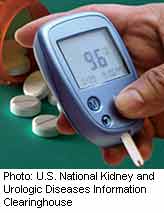Women have smaller improvement in HbA1c and more hypoglycemia and nocturnal hypoglycemia
TUESDAY, May 26, 2015 (HealthDay News) — For patients with type 2 diabetes, there are gender-based differences in glycemic control and hypoglycemia after insulin treatment, according to research published in the June issue of Diabetes, Obesity and Metabolism.
Alexandra Kautzky-Willer, M.D., from the Medical University of Vienna, and colleagues pooled data from six randomized trials of insulin glargine or NPH insulin in insulin-nave, inadequately controlled patients with type 2 diabetes. A total of 1,251 female patients and 1,349 male patients were treated with insulin glargine or NPH insulin for 24 to 36 weeks.
The researchers found that hemoglobin A1c (HbA1c) levels were significantly reduced over time for both men and women (P < 0.001), with a significantly greater decrease in HbA1c for men versus women (−1.36 versus −1.22; P = 0.002). Target HbA1C <7 percent was achieved by significantly fewer women (P < 0.001). Women had a significantly higher insulin dose/kg than men at the study end (0.47 versus 0.42 U/kg; P < 0.001). In women, the incidence rates of severe hypoglycemia and severe nocturnal hypoglycemia were significantly higher (P < 0.05 and P < 0.001, respectively). Women were significantly more likely to experience severe hypoglycemia and severe nocturnal hypoglycemia (odds ratios, 1.80 and 3.80, respectively).
“Physicians should be aware of the need to determine and closely monitor dosing, particularly in women, to optimize the balance between glycemic control and hypoglycemia risk,” the authors write.
The study was funded by Sanofi.
Copyright © 2015 HealthDay. All rights reserved.








